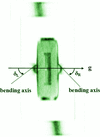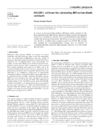issue contents
June 2012 issue

Cover illustration: Example of a three-dimensional reciprocal-space map recorded from a sample of GaAs nanowires grown on GaAs. Courtesy of Schlepütz et al. [J. Appl. Cryst. (2011), 44, 73-83].
research papers
A method is described for the calculation of the excluded-volume distance distribution for particles of arbitrary shape. Examples are given for ellipsoids, cylinders and cylinders with hemispherical end caps, of axial ratios between 0.1 and 10. Estimates of the structure factor using this method are compared with the hard-sphere approximation.
This short article presents some applications of structure-factor statistics to the determination of crystal symmetry. It is thought that this is the first application of non-ideal structure-factor statistics to real intensity data.
Download citation


Download citation


The scattering intensity of synchrotron radiation in a compact three-dimensional volume of the reciprocal space of an SrTiO3 single crystal has been measured. The diffuse pattern cannot be explained by a simple chain of just one of the displaced cations but is compatible with the displacements of Sr2+ along [001]cub (where the subscript cub denotes the cubic structure) correlated in the same direction and with simultaneous displacements of Ti4+ along [111]cub, or alternatively along [011]cub or [101]cub, while the displacements of Ti4+ are correlated along [001]cub.
Although not strictly valid, Patterson analysis is a way of analysing neutron or X-ray reflectometry data. In some special cases it could even be the preferred way, especially if a strategy for minimizing the distortion caused by the breakdown of the kinematic approximation is adopted.
A simple method to obtain the size distribution of a population of polydisperse spheres from small-angle scattering data is presented. The method is based on the deviations of the scattering signal from the Porod law and is optimized and stable for broad distributions.
Download citation


Download citation


Leverage analysis can be used to investigate the importance of weak data and the effectiveness of restraints. It can also improve the precision of estimates of selected parameters: the standard uncertainty of the Flack parameter can be reduced to 0.1 or below even for light-atom crystal structures.
Small-angle X-ray scattering experiments on composites of polymers and hierarchically structured silica reveal that internal and external forces caused by mixing processes determine the particle morphology. The strength of the interaction between the polymer chains and the particle surface does not visibly affect the experimental results.
The elastic, piezoelectric and dielectric constants of K(H1−xDx)2PO4 crystals (with composition x from 0 to 0.90) were determined using the resonance technique and impedance analysis, respectively. The reasons for the composition dependence of these constants were analyzed based on the variation of the crystal structures resolved by single-crystal X-ray diffraction.
Download citation


Download citation


Single crystals of Na0.5Bi0.5TiO3 were investigated by optical birefringence microscopy as a function of temperature. Evidence of a temperature-driven rotation of the axis of the optical indicatrix within a monoclinic plane was obtained.
Download citation


Download citation


Single-crystal chemical vapor deposition (CVD) diamonds have been investigated using small-angle X-ray scattering, X-ray topography and photoluminescence techniques. An undoped single-crystal CVD diamond proved to be an excellent window material in the characterization of protein unfolding at high pressures.
The difficulties of phasing experimental diffraction patterns obtained by the novel modulation-enhanced diffraction (MED) technique are described. Once these difficulties are overcome, MED results are better than those obtained by standard phasing methods. Indications are given for future developments.
Download citation


Download citation


A Bayesian approach is presented to quantify uncertainty in the true signal underlying noisy count data. A free software implementation has been developed.
Specific features in pair distribution functions of molecular crystals are discussed and modeling procedures introduced. As an example, the short-range order in p-terphenyl is investigated using total scattering methods.
An experimental setup is presented for automated high-throughput small- and wide-angle synchrotron X-ray scattering studies of macromolecular solutions at EMBL Hamburg.
Long-range strain can be detected by rotating a specimen along the scattering vector. This method is applied to Si devices.
On the basis of the crystallographic analysis of regularly branched InN tetrapods, it is proposed that the polytypic transition at four {111} faces of a truncated tetrahedral nanocore plays an important role in the branching regularity.
The high-resolution detector on the SANS-U spectrometer at the Japan Atomic Energy Agency has been upgraded by improving experimental efficiency with the optimization of the thickness of a ZnS/6LiF scintillator.
Download citation


Download citation


A closed analytical expression for the form factor of spherical core–shell particles, with independent Schulz–Flory size distribution functions for both the core size and the shell thickness, is derived. The results of the analytical expression are identical to numerical results and existing analytical expressions for homogeneous spheres.
An analysis of polycrystallinity in tetragonal hen egg-white lysozyme by means of energy-dispersive Laue diffraction techniques using a pnCCD detector is presented.
Download citation


Download citation


Ice VI is an important rock-forming mineral phase in icy planetary bodies; the pressure and temperature dependence of its density have been measured using powder neutron diffraction, throughout the high-pressure stability field, to obtain an accurate equation of state parameterization. These data are used to derive other thermodynamic quantities of use in planetary modelling.
This paper reports the results of time-resolved synchrotron powder diffraction and small-angle scattering experiments designed to investigate the formation of potassium jarosite.
Efficiency corrections for polarized small-angle neutron scattering are presented and the accompanying software, Pol-Corr, is described.
Algorithms for the separation of nuclear and magnetic polarized small-angle neutron scattering at all angles, including the case of anisotropic samples, are presented.
computer programs
A web site for indirect transformation of small-angle scattering data is presented. No user input is necessary beyond the experimental data.
XDSAPP, a graphical user interface for the easy and convenient processing of diffraction data sets using XDS, is described.
ISODEC is a program for the calculation of diffraction elastic constants for aggregates with and without preferred orientation. It also calculates stress from lattice strain and vice versa.
A computer program for topological analysis of discrete electron densities is presented. Test calculations demonstrate the accuracy of the applied methods.
Open  access
access
 access
access
The foundations and current features of a widely used graphical user interface for macromolecular crystallography are described.
A novel software platform for the analysis of biological small-angle scattering is presented.
The Stokes deconvolution method followed by Warren–Averbach–Bertaut and/or Williamson–Hall analysis is implemented in easy-to-use program, XBroad, for quick extraction of basic microstructural information from powder X-ray diffraction data.
Open  access
access
 access
access
The PROSPERO server analyzes sequence and experimental protein characterization results, then uses that analysis to predict crystallization outcome and suggest priorities for futher work on difficult targets. The server allows users to upload data from six types of experiment, to organize those data by sample and project, and to share those data with collaborators.
A reusable program library to compute cold and thermal neutron cross sections and examples of its application for Bragg edge imaging are presented.
laboratory notes
A thermoelectrically cooled sample stage for X-ray powder diffraction in the range from about 250 to 300 K is described. The stage is constructed in such a way that it may be removed from the diffractometer and pre-cooled to its base temperature before the sample is loaded.
crystallographers
Free 

book reviews
Free 

books received
Free 



 journal menu
journal menu

























































